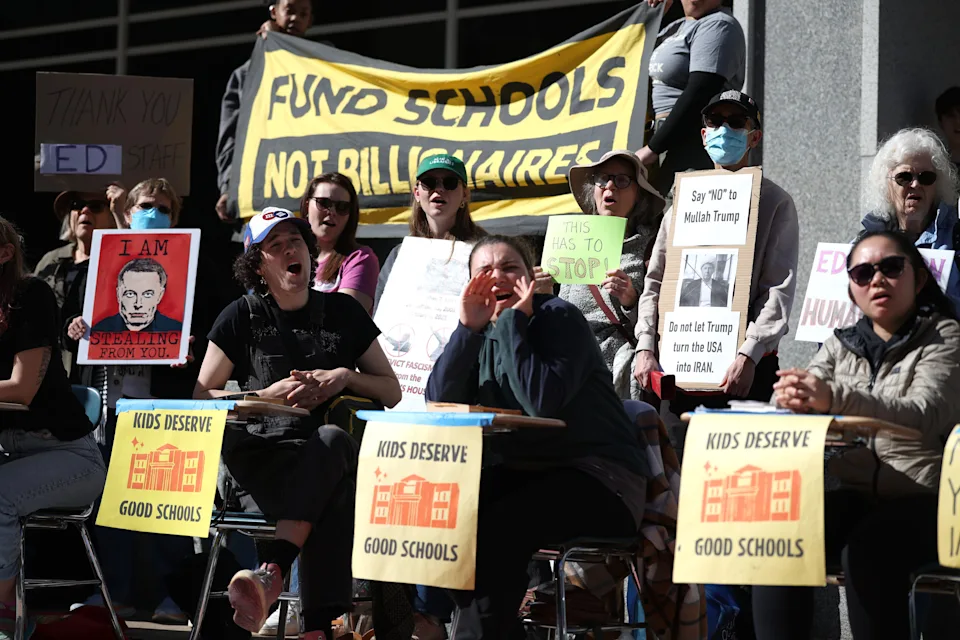
Beneath the Surface: The Ripple Effects of the Trump Administration’s $7 Billion Education Funding Freeze.
Posted in :
The Trump administration’s $7 billion K–12 education funding freeze has devastated after-school programs, teacher training, and services for vulnerable students. The move triggered legal action and exposed deep cracks in public education funding.
The Trump administration’s abrupt freeze of nearly $7 billion in federal education funding has sent shockwaves through schools nationwide. This outline explores the personal, political, and practical impacts—focusing on who’s most affected, the legal and ethical questions raised, and the uncertain road ahead. Expect an unfiltered, relatable exploration into what these funding cuts might mean for classrooms, communities, and the American dream itself.
On a rainy morning in July, a school superintendent somewhere in Iowa opened an email that changed everything. Instead of the confirmation for much-needed federal funds, she found a terse message: nearly $7 billion in education funding—money her district had banked on for after-school snacks, reading tutors, and support for English learners—was suddenly out of reach. If you ever thought ‘federal budgets’ were a distant government drama, this year it got personal for millions. How does a decision made in D.C. ripple all the way to your child’s classroom—and what happens next? Let’s dig in, sidestepping the headlines to see what’s really at stake when the funding rug gets pulled out from under America’s schools.
Where the Money Didn’t Go: Mapping the Impact on Classrooms and Communities
When news broke that the Trump administration was freezing nearly $7 billion in federal education funds, the shockwaves hit classrooms and communities across the country almost instantly. This wasn’t just a line item on a budget; it was a lifeline for millions of students, teachers, and families. The impact on states and schools is already being felt, with K-12 school funding cuts forcing tough choices in districts big and small.
Which Programs Lost Funding?
Let’s break down where the money was supposed to go—and what’s now at risk:
- After-/Before-School Programs: $1.4 billion
- Academic Enrichment: $1.3 billion
- Professional Development (Teacher Training): $2.2 billion
- English Learner Services: $890 million
- Migrant Education: $375 million
These grants aren’t just numbers—they fund after-school care, summer learning, teacher workshops, and critical support for English learners and migrant students. Now, with the federal education funds withheld, districts are scrambling to fill the gaps.
Stories from the Ground: Real Lives, Real Losses
Consider a rural district in the Midwest. Last year, their after-school art program was a bright spot for dozens of kids—many from low-income families. With the funding freeze, that program vanished overnight. Teachers who once stayed late to mentor students now find themselves organizing bake sales just to buy classroom supplies. One principal shared, “We’ve gone from planning field trips to fundraising for pencils.”
It’s not just art programs. In some places, academic enrichment clubs, STEM camps, and even basic tutoring have been put on hold. For English learners, the loss of $890 million means fewer bilingual aides and less support for students still mastering the language. Migrant education programs—already stretched thin—are now facing the prospect of layoffs and canceled summer sessions.
Who’s Hit the Hardest?
Research shows the funding freeze disproportionately affects high-poverty districts and students with special needs. Low-income families, migrant children, and English learners are bearing the brunt of these K-12 school funding cuts. For many working parents, after-school programs aren’t just enrichment—they’re essential childcare. Without them, parents are forced to scramble for alternatives, sometimes risking their jobs.
The ripple effects don’t stop at the schoolhouse door. When after-school programs close, local economies feel it too. Fewer staff means fewer paychecks, and small businesses that supply schools—like bus companies and caterers—lose contracts. The impact on states and schools is deep and wide, touching everything from classroom morale to community stability.
States in the Crosshairs: The 15% Club
While every state and territory is affected, some are facing a much steeper climb. At least 17 states and territories are losing 15% or more of their overall K-12 funding due to the freeze. That’s not a small dip—it’s a budget cliff. In California, state leaders are even considering legal action to force the release of funds. Meanwhile, districts in Texas, Florida, and New York are warning parents about program cuts and staff layoffs.
The migrant education funding freeze is especially devastating in states with large agricultural communities. In places like Arizona and Georgia, schools that serve migrant families are bracing for a summer without the resources they need to keep kids learning—and safe.
Voices of Outrage: Educators and Advocates Speak Out
“Withholding billions in promised federal education funding that students need—and states had planned to use to support children in their states—is a cruel betrayal of students, especially those who rely on critical support services.” – Becky Pringle, National Education Association
Advocacy groups and educators aren’t mincing words. They’re calling the move an “all-out betrayal” of working families and a direct attack on the most vulnerable students. As states and districts scramble to adjust, the message from Washington feels clear: schools are on their own.
The debate over the federal education funds withheld isn’t just about dollars and cents—it’s about the future of public education, and whether every child will have a fair shot, no matter their zip code or background.
The Politics (and Drama) Behind the Freeze: Why Now and Who’s Really Calling the Shots?
When news broke that the Trump administration had suddenly frozen nearly $7 billion in federal education funds, it wasn’t just a bureaucratic hiccup—it was political theater with real-world consequences. The Trump administration’s move to withhold these funds, which had already been approved by Congress and signed into law by President Trump himself, left states and educators scrambling. The money was supposed to hit school accounts on July 1, but instead, officials received a terse message: “decisions have not yet been made concerning submissions and awards for this upcoming year.”
So, why now? And who’s really behind the curtain pulling the strings?
Trump Administration Freezes Education Funds: The Official Line
The Trump administration has never been shy about its intentions to scale back the federal government’s role in education. The FY 2026 Trump education budget proposal goes even further, proposing the full elimination of many of the same programs now caught in the freeze. These include grants for after-school and summer programs, professional development, English-learner services, and migrant education—programs that serve millions of students, especially in high-poverty districts.
- $2.2 billion for professional development
- $1.4 billion for before- and after-school programs
- $890 million for English-learner services
- $375 million for migrant education
Research shows that these programs are lifelines for vulnerable students, and the sudden freeze has left districts in 33 states reeling, forced to suspend initiatives and rethink budgets on the fly.
Senator Patty Murray Criticism: Not Just a Policy Choice, But a Legal Battle
It didn’t take long for the political pushback to begin. Senator Patty Murray, a leading voice on education, called out the move as more than just a policy decision. In her words:
“President Trump himself signed this funding into law—but that isn’t stopping him from choking off resources to support before and after school programs, help students learn, support teachers in the classroom, and a lot more.”
Senator Chris Murphy echoed the legal concerns, calling the freeze a “CLEAR AS DAY violation of federal law.” He pointed to appropriations law, which requires the executive branch to spend funds as directed by Congress. The term “impoundment” is now front and center—essentially, the administration is being accused of illegally holding back money that must be spent. California and other states are already exploring legal challenges to the funding freeze, arguing that this is not just bad policy, but a breach of the law itself.
The Office of Management and Budget Role: Quiet Power, Big Impact
While the Department of Education delivered the news, the Office of Management and Budget (OMB) is the real power player here. The OMB’s behind-the-scenes influence is critical—they’re the ones reviewing and recommending whether these “temporary” freezes become permanent cuts, or “rescissions.” The FY 2026 Trump education budget proposal, which wipes out these programs entirely, is a clear signal of where the administration wants to go. The OMB’s role in this drama can’t be overstated; they’re the gatekeepers who could make this freeze stick for good.
Accountable.US Trump Funding Betrayal: Watchdogs and Advocacy Groups Speak Out
Advocacy groups haven’t minced words. Tony Carrk, executive director of Accountable.US, called the freeze an “all-out betrayal of working families.” In his words:
“Trump’s education funding freeze will shutter after-school programs, rob classrooms of resources, and set students struggling with years of learning loss back even further.”
Groups like the National Education Association have also sounded the alarm, labeling the move “shocking, but not surprising.” They argue that the Trump administration’s actions are not just harmful—they’re unconscionable, especially as schools face teacher shortages, burnout, and under-resourced classrooms.
Legal Challenges to Funding Freeze: The Next Battle
With legal experts and lawmakers lining up to challenge the freeze, the drama is far from over. California and other states are weighing lawsuits, and the debate over “impoundment” could end up in the courts. The Office of Management and Budget’s suggestion that these funds could be permanently rescinded only adds fuel to the fire. For now, states and school districts are left in limbo, waiting to see if the money Congress promised will ever arrive—or if this is just the beginning of a much larger fight over the future of public education in America.
‘Unprecedented Times’ for Families and Schools: Scrambling, Lawsuits, and Looking for Silver Linings
When the Trump administration abruptly froze nearly $7 billion in federal K-12 education funding, it sent shockwaves through schools and communities across the country. The move, which affected 33 states and threatened thousands of after-school and summer programs, left districts and families scrambling for funding and answers. For many, it felt like the rug had been pulled out from under them—just as they were already struggling with teacher shortages, burnout, and under-resourced classrooms.
The impact of the K-12 funding freeze in 2025 has been especially harsh on low-income students and vulnerable populations. Programs supporting English learners, migrant children, and students in high-poverty districts were among the hardest hit. Teachers, already stretched thin, found themselves reaching into their own pockets to buy classroom supplies. Parents, meanwhile, began organizing grassroots fundraisers and crowdfunding campaigns, hoping to fill the gaps left by missing federal dollars. It’s a scene that’s become all too familiar: communities rallying together, improvising solutions, and doing whatever it takes to keep kids supported.
But the scramble for resources is only one part of the story. As districts and states face tough decisions—cutting programs, suspending summer learning opportunities, and reconsidering staffing—legal challenges to the funding freeze are beginning to simmer. Civil rights groups, advocacy organizations, and state governments are joining the fray, arguing that the Trump administration’s move is not just harmful, but illegal. The National Education Association response has been swift and forceful, with President Becky Pringle calling the freeze “a cruel betrayal of students, especially those who rely on critical support services.” She points out that schools were counting on these funds, and that withholding them is “outrageous and unconscionable.”
Lawmakers have also weighed in, with Senator Patty Murray criticizing the administration for choking off resources that were already signed into law. And in a pointed rebuke, Senator Chris Murphy declared,
‘This is a CLEAR AS DAY violation of federal law. The appropriations law passed by Congress REQUIRES this money to be spent.’
The legal challenges to the funding freeze are likely to intensify, especially as the Supreme Court education funding crisis adds another layer of uncertainty. The recent Supreme Court decision on national injunctions has made it even harder for states to quickly block federal actions, leaving many wondering what comes next.
Research shows that states and local districts are resorting to stop-gap measures amid the funding freeze. Some are suspending after-school programs, while others are cutting back on professional development or delaying much-needed upgrades to facilities and technology. The Office of Management and Budget has even suggested that the frozen funds could be subject to future rescissions—meaning they might never be released at all. For families and educators, the uncertainty is exhausting. Every day brings new questions: Will the money come through? Will programs survive another year? How much more can communities be expected to shoulder on their own?
Yet, even in the midst of this crisis, there are glimmers of hope and innovation. Some districts are experimenting with community-driven solutions—partnering with local businesses, launching crowdfunding campaigns, and seeking sponsorships to plug funding gaps. These efforts, while inspiring, also highlight the deep inequities in American education. Not every community has the resources or connections to make up for lost federal support. The crisis could be a catalyst for new models of local school funding, or it could deepen the divide between well-resourced and struggling districts.
The National Education Association and other advocacy groups are calling for a renewed commitment to stable, equitable federal support for public education. They argue that the K-12 funding freeze of 2025 is not just a policy dispute, but a battle for the heart and future of public schools in America. As legal battles ramp up and the Supreme Court weighs in, the stakes couldn’t be higher. The question now is whether this unprecedented moment will spark meaningful change—or leave families and schools scrambling for years to come.
TL;DR: The Trump administration’s $7 billion education funding freeze leaves millions of students, especially the most vulnerable, in limbo. Programs could shutter, legal battles and political drama are looming, and the impact will echo in classrooms for years. When federal dollars dry up, real lives—kids, teachers, families—bear the brunt.
TrumpAdministrationFreezesEducationFunds, $7BillionEducationFundingFreeze, FederalEducationFundsWithheld, K-12SchoolFundingCuts, FundingCutsToAfter-schoolPrograms, ImpactOnEnglishLearners, NationalEducationAssociationResponse, K-12FundingFreeze2025, TrumpEducationBudgetProposal2026, ImpactOnStatesAndSchools,Trump, education funding, K-12 cuts, federal freeze, after-school programs, migrant education, Patty Murray, Chris Murphy, OMB, public schools,K-12schoolbudget cuts, impactonEnglishlearners, migranteducationcrisis, legalbattleoverschoolfunding
#EducationCrisis, #SchoolFundingFreeze, #K12Education, #EquityInEducation, #TrumpAdministration, #AfterSchoolPrograms, #MigrantEducation, #EdPolicy, #EducationImpact, #BudgetCuts,#EducationFunding, #TrumpCuts, #K12Crisis, #MigrantEducation, #LegalChallenges, #AfterSchoolPrograms, #PublicSchools, #BudgetFreeze

